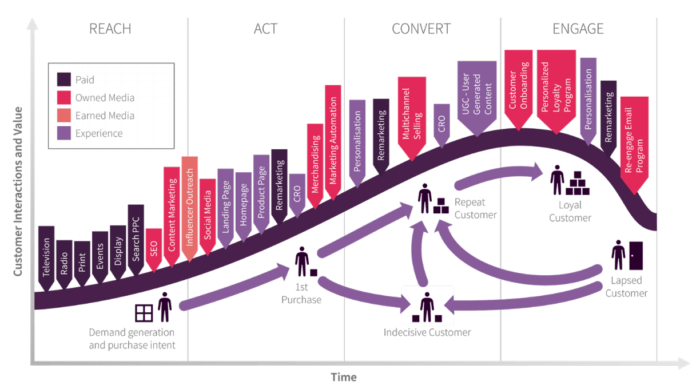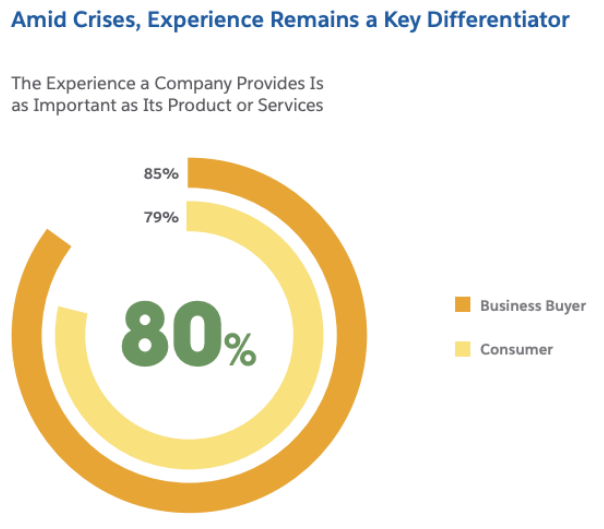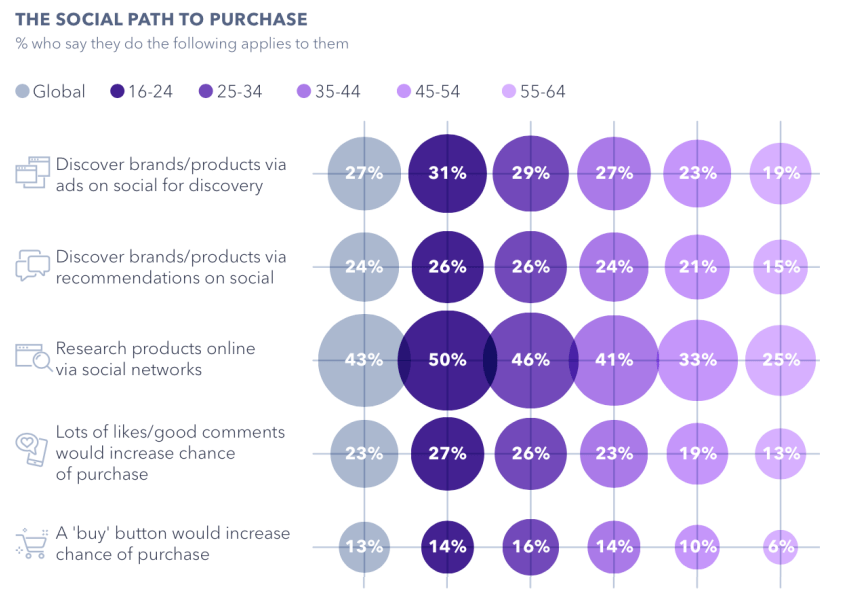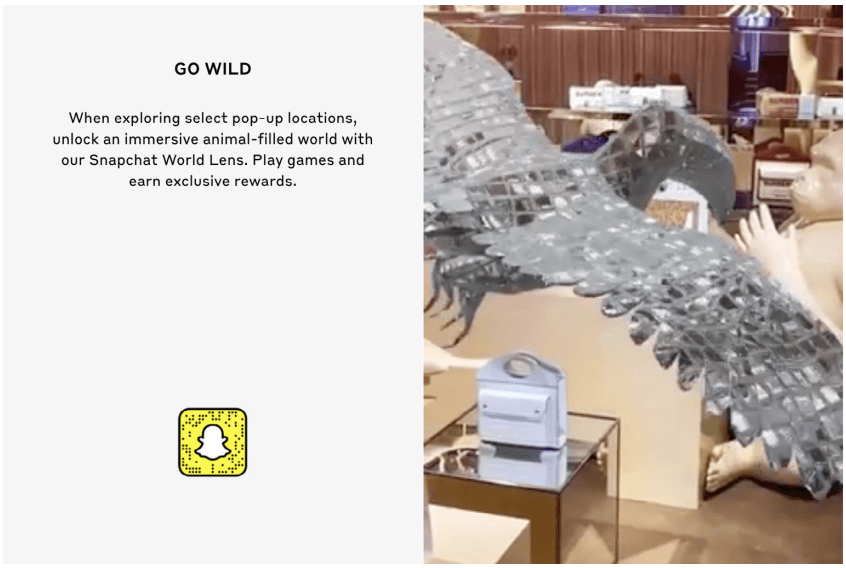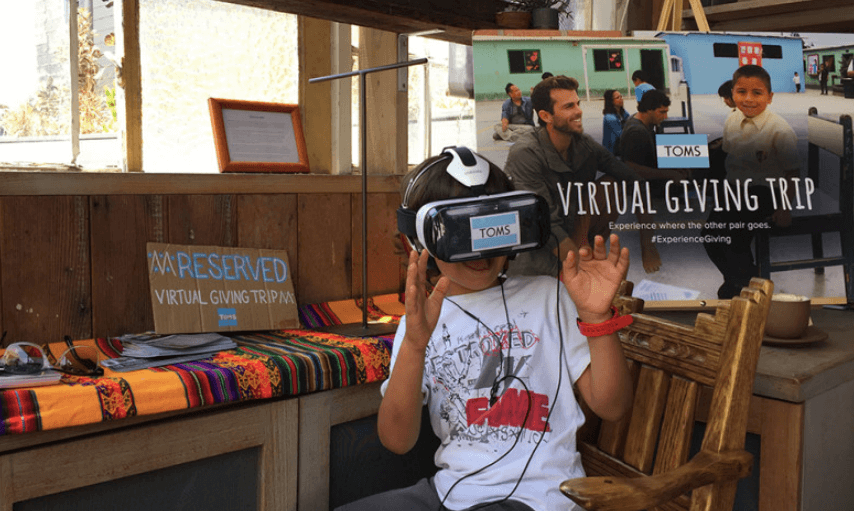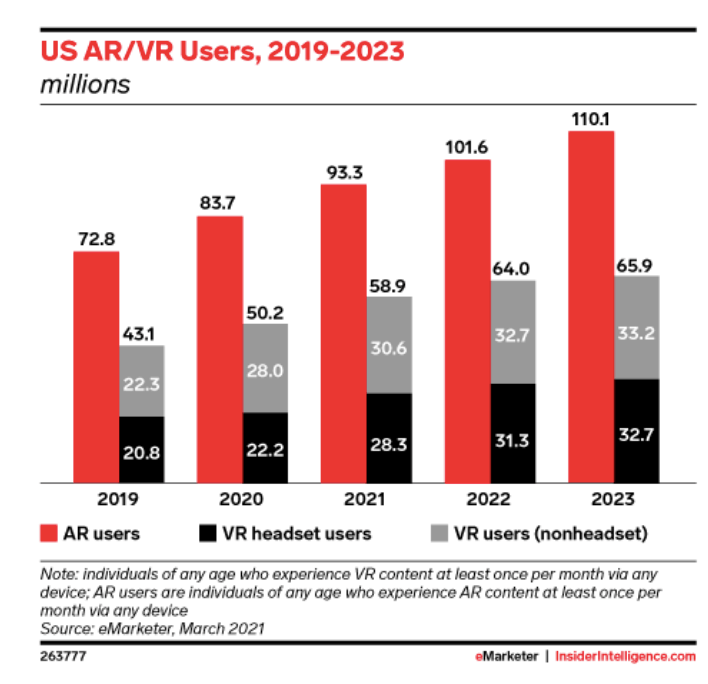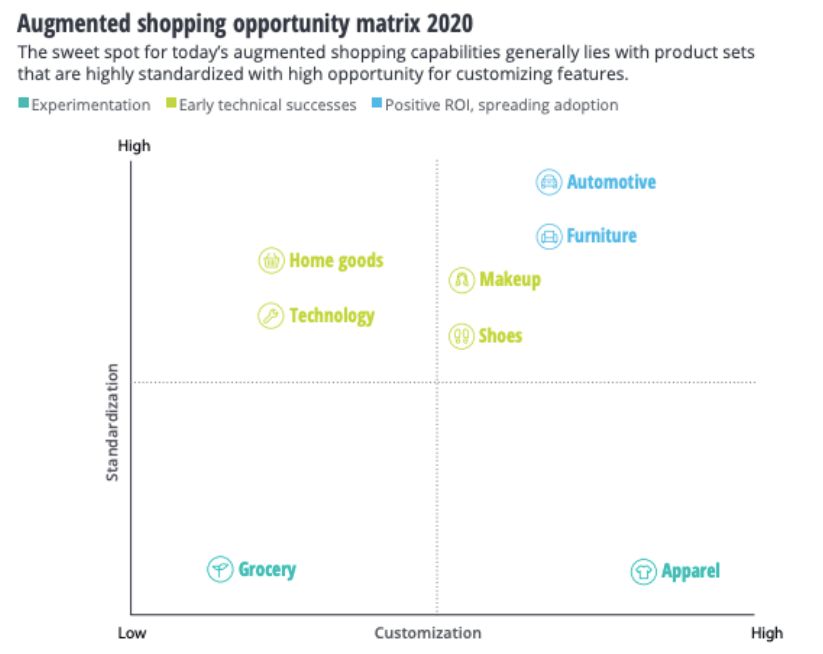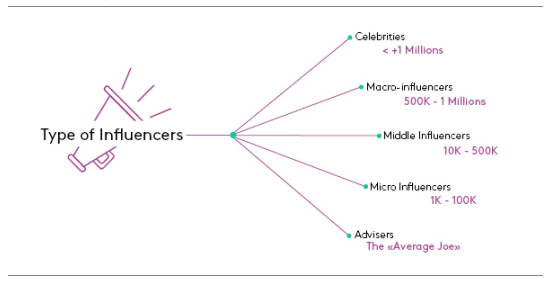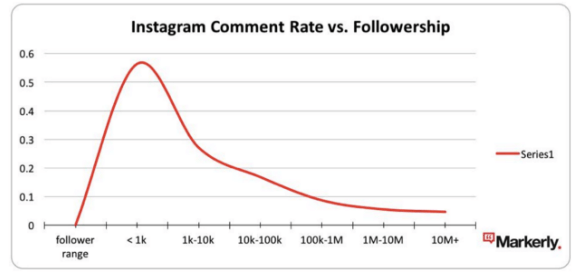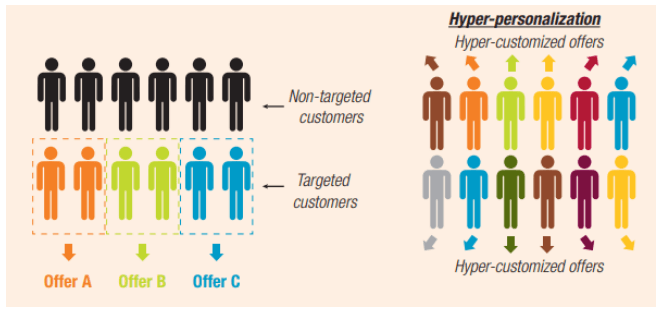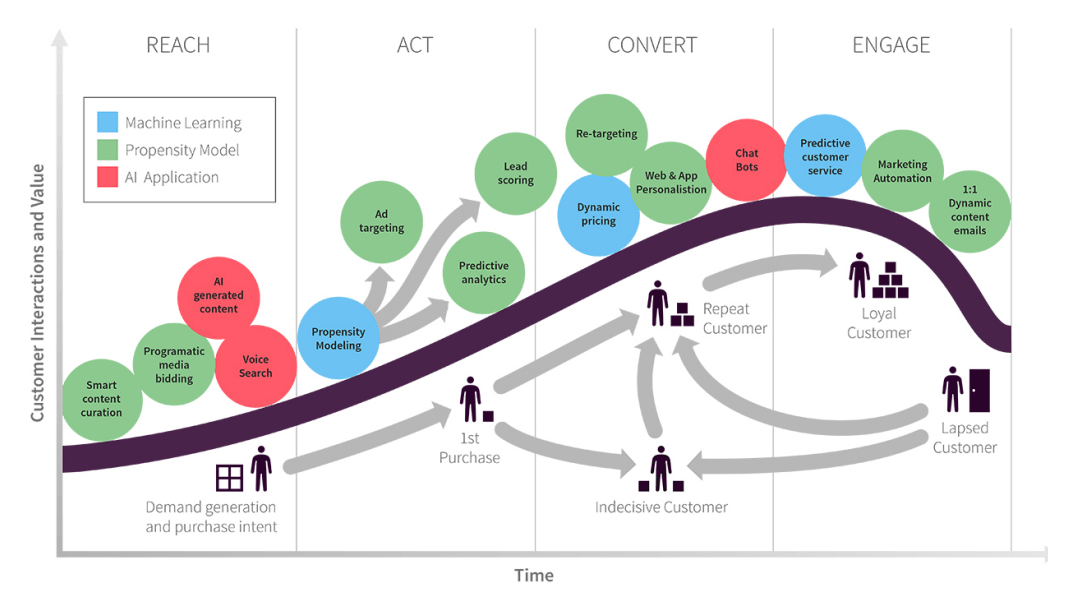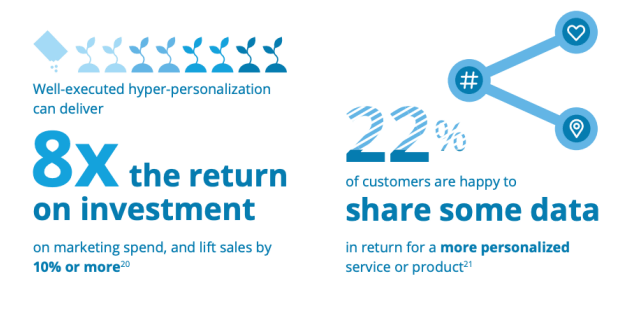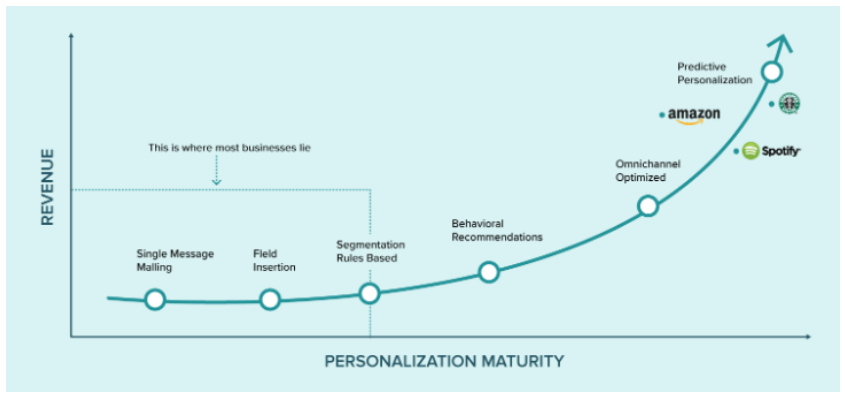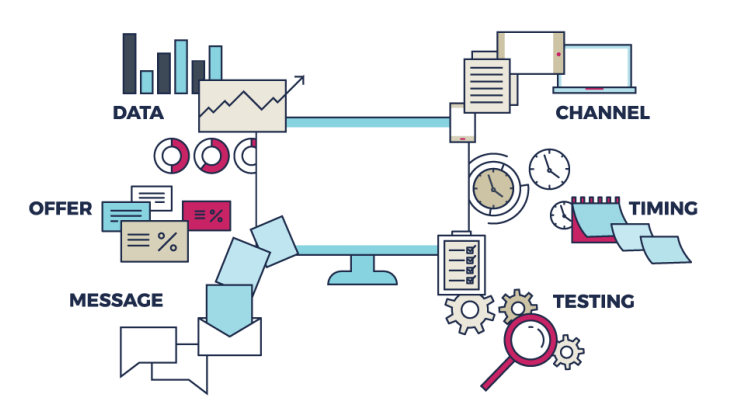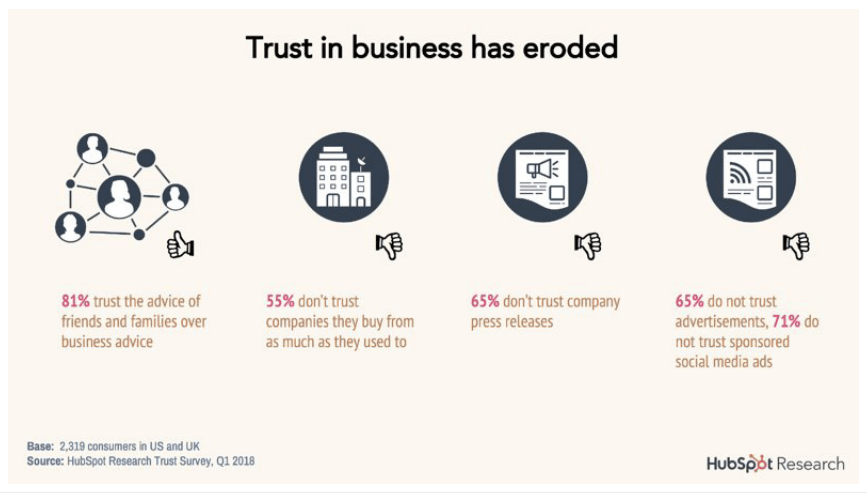We round up the top trends and innovations for marketers of consumer branded goods in 2022, integrated across the RACE Framework, to inform your marketing strategy
Our marketing trends for consumer brands 2022 guide covers the top trends in consumer branded goods across our 5-step strategy of plan, reach, act, convert, and engage (the RACE Framework). Our acclaimed RACE Framework is loved by consumer brands marketers worldwide due to its practical, data-driven approach to marketing strategy, designed to generate growth, fast. See below.
Read on to discover a couple of brand marketing trends from the report, integrated across the RACE Framework. To find out more about how your brand can incorporate the latest trends and innovations into your marketing strategy, why now download your free copy of the 2022 marketing trends for consumer brands guide now?
Packed with best-practice, case studies, practical next step recommendations, this is the guide that every brand marketer needs in their toolkit heading into 2022. Download your free copy today.
PLAN: Consumer brand digital transformation
Without a doubt, the world of consumer marketing has transformed beyond recognition in the past 18 months. Savvy consumer goods brands marketers need to consider digital transformation when planning their plan of attack for 2021.
Yih-Choung Teh, Ofcom’s Director of Strategy and Research, said:
“Lockdown may leave a lasting digital legacy. The coronavirus has radically changed the way we live, work and communicate online, with millions of people using online video services for the first time.”
Today’s consumer has higher expectations of service delivery and they demand it at speed. Apart from Covid-19’s impacts, it is no longer acceptable to be asked to wait. We are very much living in the ‘now generation’ and, to keep pace, the digital revolution has stepped up a gear.
As consumers have spent more time online, their expectations of those digital experiences have never been higher. As activities taking place in the Reach stage of the RACE Framework are some of the first contacts your audience may have with you, it is all the more crucial that this contact is smooth, quick and of very high quality.
Many brands were already well underway with transforming their digital capabilities to meet customer needs, and COVID-19 just became the catalyst. Organizations were working hard to make this shift to become a digital-first business. Others had taken small steps but were forced into speedier adoption out of necessity. The pandemic has therefore compelled both businesses and consumers to expedite the process.
Salesforce surveyed consumers after the pandemic and found that 88% of them expect
companies to accelerate digital initiatives due to COVID-19.
Rethinking the customer experience
Modern marketing requires a business to identify and nurture internal capabilities to provide the best experience for the customer. This is a key element of any growth strategy.
Delivering the promise of a rich customer experience demands an entirely new way of operating and relies on a strategy that is aligned to digital transformation at each stage. Marketing functions are adopting a more agile, collaborative, and customer-focused approach. This is particularly important as consumers have adopted new platforms as the norm.
Ofcom reported that in the 12 months leading to February 2020, of UK online adults:
- 52% were sending daily text messages using messaging platforms such as WhatsApp and Facebook Messenger
- 41% used SMS daily
- 26% used emails daily
- 31% made of online voice calls
- 38% made mobile calls
The objective is therefore not to look at the activities of the marketing strategy but more so about how the strategy intends to provide them to align with consumer behaviors.
To learn more about the best practices for structuring digital communication goals and objectives, download your free copy of our marketing trends for consumer brands 2022 guide.
Digital maturity amongst consumers
Customers have become more digitally mature and comfortable in conducting online research for virtually every purchase decision.
This means the relationship between a brand and a consumer is critical to the lifecycle. Moreover, today’s consumer is more aware than ever of the role that brands play in their day-to-day lives, and limitations in service delivery are more transparent.
Brands must move away from a reactive digital approach to align themselves to this growing trend of consumerism – especially at the REACH stage where information that will influence their choice is gathered.
To truly achieve this, organizations must set digital marketing maturity as the objective. Making this an achievable KPI will help to get engagement across teams, regions and geographical departments to make the shift towards a digital-first marketing strategy.
If you’re reading this and wondering about your own organization’s Digital Marketing Maturity, don’t worry – you’re not alone! Your next step is to download your free copy of our marketing trends for consumer brands 2022 guide. Our guide is packed with best-practice, case studies, practical next step recommendations, this is the guide that every brand marketer needs in their toolkit heading into 2022. Download your copy today.
Data-driven strategy
These consumer habits are here to stay.
Existing customers expect the brands that they interact with to know who they are. It is taken for granted that the end-to-end journey is joined up for a more streamlined and efficient experience.
Where this is missing, today’s consumer is easily frustrated. Lack of this customer insight can duplicate interactions, generic communications, or impersonal service. One bad experience can indefinitely destroy a customer relationship or view of a brand.
70% of millennials are frustrated with brands sending irrelevant emails, but there is no reason for this to happen in a data-driven landscape. Brands collect huge volumes of information about who their customers are and what drives their behavior. The task is then to use the intelligence to refine strategies that will create brand experiences that consumers want.
Connecting the dots across devices so that the consumer receives a joined-up experience is where businesses are focusing their investment over the next five years.
Holli Barrett, Head of CX at Space 48 comments:
“The cornerstone of loyalty is a customercentric approach where you offer a great experience and build trust with your shoppers. But that’s just the beginning, you also need to ensure your customers feel valued and rewarded for their loyalty and that you leverage personalization by creating offers you know will interest them.”
Digital Transformation doesn’t have to be daunting. We’ve developed an interactive Digital Transformation Learning Path for Business Professional Members that breaks down why and how you should use a data-driven approach to plan, manage and optimize digital marketing activities at a strategic level. Each module in the Digital Transformation Learning Path takes only around 15 minutes to complete and even saves your progress, so you can improve your skills and benefit your organization as and when your schedule allows.
You’ll find out more about how your company can benefit from Business Membership when you download your free copy of our marketing trends for consumer brands 2022 guide. By reading through each trend and innovation for marketing for consumer brands, you’ll be able to make an informed decision when it comes to investing in growth for your company. Download your copy today to start your journey.
REACH: Augmented omnichannel marketing for consumer brands
The RACE framework covers all aspects of a customer lifecycle and helps you to define a true omnichannel strategy. This report begins with the Reach stage of RACE, which focuses on techniques for growing your audience and increasing awareness. Your key measures at this stage are audience volume, quality, value and cost (VQVC).
Omnichannel is a multichannel approach that seeks to provide customers with a seamless shopping experience. It is device-agnostic, so whether they’re interacting online, via the telephone, or in a brick-and-mortar store, they can have a smooth and coherent transaction.
John Bowden, Senior VP of Customer Care at Time Warner Cable, clarifies how multichannel differs from omnichannel:
“Multichannel is an operational view – how you allow the customer to complete transactions in each channel. Omnichannel, however, is viewing the experience through the eyes of your customer, orchestrating the customer experience across all channels so that it is seamless, integrated, and consistent. Omnichannel anticipates that customers may start in one channel and move to another as they progress to a resolution. Making these complex ‘hand-offs’ between channels must be fluid for the customer. Simply put, omnichannel is multichannel done right!”
Today’s interactions are happening in many different contexts. Consumers are browsing at home, on the go, and on the high street.
In 2020, UK online sales growth rose by 36.6%, but despite this, in-store is still critical. In fact, for many brands, the sweet spot will be a blend of channels and a mindset that considers all the channels at once; omnichannel. Shimona Mehta, managing director, EMEA at Shopify, commented, “The high street is not dead – it’s just evolving to suit a modern way of life. There’s no question that high streets will continue to play an important role in all our lives.” A big trend in omnichannel branding is through the adoption of AI technologies.
Marketing using augmented and virtual reality allows brands to craft experiences, engage consumers and encourage conversions in interesting ways. Artificial intelligence and 3D technologies can therefore transform the heart of omnichannel, creating personal experiences to interact with brands, both on- and offline.
Done properly, augmented experiences can help consumers to engage with brands, shop with more confidence, and configure a personalized service that feels authentic. Find out more about opportunities within augmented omnichannel for your brand by downloading our marketing trends for consumer brands 2022 guide.
Reaching the virtual customer through augmented reality (AR)
AR is an emerging trend in marketing and sales to allow customers to engage with brands via a fully digital experience through the convenience of their mobile devices.
AR can shorten sales cycles, reduce the cost of marketing and sales logistics, and immerse customers to set brands apart from rivals.
The potential reach of AR shows is massive, and this shows that there’s a huge potential as a technique to entice audiences and add them to the marketing funnel. A report by Deloitte shows that there are over 1 billion smartphones out there capable of delivering an augmented experience and over 100 million consumers are likely to shop using augmented reality (AR) within the next year.
A global survey by Nielsen showed that consumers listed augmented/virtual reality (VR) as the top technology they’re seeking to assist, amplify, and augment their daily lives. Back in 2019, around 51% of them stated that they would be willing to use AR/VR if it were available.
Speeding forward to 2021, with the expedited investment in technology, this is now a reality for consumer brands.
Example: Burberry Animal Kingdom
Amidst the global pandemic, fashion label Burberry launched a series of worldwide ‘Animal Kingdom’ pop-ups to celebrate exclusive editions of its signature bags and accessories.
To support it, Burberry partnered with Snapchat to release an in-store gamified experience. By scanning the Snapcodes embedded in the pop-ups, players were transported into the world of Burberry’s Animal Kingdom and see the animals around them come to life. The experience allowed Snapchat users to create their own content to share on their social media platforms, helping to amplify the reach of the campaign.
Virtual reality (VR) marketing
VR marketing bridges the gap between experience and action. It creates a fully rendered digital environment that replaces the ‘real-world’ in a 360 degrees view – usually through headsets with special lenses.
Brands are using VR to offer a digital experience in place of a physical one, which can promote products and services.
As well as promoting existing products, VR can also showcase development to spark interest in consumers. This can elicit investment from prospects but also allow for open feedback. With this kind of immersive experience, consumers are choosing to interact with a brand.
Example: Toms: Virtual Giving Trip
Toms, the shoe company, is well known for strong charitable values, donating one pair of shoes to a child in need every time a customer buys a new pair. Using VR headsets, it created The Toms Virtual Giving Trip taking viewers on a trip through Peru.
The experience allowed consumers to visit the children of a school which had received their gifted shoes to see first-hand where their donations were going. Through the power of VR technology, TOMs was able to create a truly intimate and powerful experience.
A move to augmented shopping
AR technology overlays digitally created content into the user’s real-world environment. This has enabled consumers to try on, try out, or personalize products virtually within their own surroundings.
This means that brands can reach a whole new audience. No longer are physical boundaries an obstacle for growing an audience. To today’s consumers, the location of a store now bears no relevance to trying or viewing a product.
AI can serve more personalized messaging in a format that’s preferable to a consumer’s
behaviors. Technology can provide real-time answers, and leverage data to allow marketers to pinpoint individuals for an immersive experience as part of an
omnichannel strategy.
Augmented shopping opportunity currently lies in high standard product sets, but which offer the opportunity to customize features. For example, automotive, fashion, furniture, etc.
Tools such as Vuforia and Wikitude can provide immersive experiences to customers.
Case study: DFS allows customers to see sofas in their rooms
Situation: Choosing and buying a new sofa can be a lengthy process. From looking at options, colors, configurations, trying it out to ultimately buying can take weeks if not months. Leading UK upholstery retailer, DFS wanted to improve the online shopping experience and make the purchasing decision much easier.
Solution: DFS developed an online and mobile AR experience that places furniture in the room virtually. Shoppers can see how an item may look and see whether it will fit before they buy. Using the feature, customers could point the mobile device at any space in the lounge using the camera function, and then move the piece around the room in real-time and to scale.
Results: 90% of DFS customers are said to research items online first. Using AR tools, customers have been able to use smartphones to visualize a wider range of models and colors in their own living space without an initial visit to a store.
Through a shared web-to-store customer basket, customers are then able to create an editable shortlist of preferred options to take into the showroom having made an online appointment.
Our marketing technology and media innovation guide for Business Professional Members helps you identify the most important new technologies for achieving your marketing goals, many of which will be of particular use when building your brand’s online footprint – whether through paid or organic activities.
CONVERT: Micro-influencer marketing for consumer brands
According to Instagram, 87% of people say that influencers have inspired them to make a
purchase.
Influencer marketing is a key element in the marketing mix for consumer brands and is now considered to be a mainstream digital marketing tool. The concept uses the idea of celebrity endorsement within the context of social media content.
The execution is through brand collaborations, partnerships, or sponsored advertising, and as the audiences trust the figure, they are more likely to buy into a brand that they advertise.
Influencer marketing has been around for a while now, and typically brands would look at the size of the following to place a value on the importance of the partnership. In doing so, a brand could expect to attract high reach numbers, but also a bigger cost for access to the audience.
Using followers as a metric doesn’t always equate to the most efficient response.
Rise of the micro-influencer
A micro-influencer has a much more modest following than a typical public figure; fewer than 100,000 and the difference is that they have a hyper-engaged following. Followers build a genuine relationship and have trust in the micro-influencer.
Building a relationship with a micro-influencer is a growing trend that brands are adopting to aid the conversion process.
For example:
Influencer A has 2 million followers.
- They collaborate with several brands to create content on a range of topics.
- They are known globally or across a wide geographical area.
- A large proportion of their followers subscribe purely because they are ‘famous’ rather than because they feel an affinity.
- E.g., a Hollywood movie star or international sports personality.
- They will charge a high fee for access to their audience.
Influencer B has 10,000 followers.
- They only endorse brands that are relevant to their content.
- They share stories on a niche interest and interact with an engaged community who are also interested in their niche interest.
- People follow them because they have shared values, likes, perceive them to be an expert, or their content is of true interest. E.g., a personal trainer.
- They will charge a lower fee, or even promote a brand in return for a free product.
In this example, the relationship between a relevant brand and influencer B will elicit a better response because the link is authentic. The brand is one which the hyper-engaged community may be inclined to believe in as the person whose opinions matter has endorsed them. They are perceived to be ‘just like me’ rather than have an unachievable lifestyle.
The collaboration between influencer A and the brand may be less transparent and harder to convince.
For this reason, in the context of the RACE Framework, using micro-influencers who have a loyal and engaged following in a particular vertical can support the Convert stage. Find out more about micro-influencer opportunities for your brand by downloading our marketing trends for consumer brands 2022 guide.
Longer-term partnerships
Influencer marketing has previously been driven by one-off projects. Ads, sponsored posts, or collaborations to fit with a corporate campaign, for example. Trends show that it is much harder to quantify the ROI of influencer marketing on this basis.
Brands are moving towards ongoing projects as they attempt to measure the impact that the tool has on the conversion rate. Ultimately, depending on the industry, product or ticket price, it can take time to make a sale. By engaging with a micro-influencer to create a strategic partner over a longer period, such as a series of sponsored posts, a brand can build more loyalty and a more legitimate relationship to support the purchase decision process.
Shoppable content
As discussed already, social commerce is a key trend that all brands should be aware of. Shoppable videos and shoppable posts can create a seamless user experience directly from the influencer to the brand and play a key role in the social commerce strategy.
Brands are increasingly asking micro-influencer to incorporate social shopping into partnerships.
Five steps to micro-influencer campaigns
A micro-influencer campaign needs to be part of an integrated strategy. We’ve previously written an in-depth guide to how to collaborate with micro-influencers including:
- Goal setting
- Determining budget
- Finding the right influencers
- Creating engaging content
- Measuring the results
To find out more, why not complete our interactive Learning Path module on influencer marketing? You’ll learn specifically what different kinds of influencers you can work with, the tools you can use to find them, and the success factors of strategic influencer relationship management.
Case Study: Iceland supermarket
Situation: UK frozen food supermarket, Iceland Groceries’ approval ratings plunged to an all-time low at 10%. They had previously used celebrities for advertising campaigns, but the campaigns were failing.
Solution: Iceland realized that the campaigns weren’t making the right impact because the celebrities weren’t ‘real’ people. They changed tack and began to work with 50 micro-influencers over a year-long strategy with parenting and everyday food bloggers to capture some UGC. They also implemented social listening and paid advertising to share the message.
Results: Iceland reported a 55% retention rate on Facebook videos (59% on YouTube), and an approval rating increase from 10% to 70%.
Download our marketing trends for consumer brands 2022 guide to keep on top of the latest trends and innovations your company could be using to convert more customers.
ENGAGE: Hyper-personalization marketing for consumer brands
Hyper-personalization takes segmentation to another level to improve engagement rates and ROI.
It allows organizations to build a unique profile of consumers that learns and adapts to behavior over time. Tools can collect demographics, location, and browsing history to deliver optimal customer experiences in real-time, targeted to their preferences.
Brand engagement is all about encouraging repeat business, brand loyalty, and advocacy. Don’t miss our latest tips to help you secure and retain high-value customers.
Personalized content
Brands now understand that a one-size-fits-all approach isn’t effective in engaging with customers and prospects.
Consumers care even more about experience than before the pandemic when deciding which companies to support or buy from and they only want to see the content that is relevant to them. A Deloitte study found that 90% of customers said personalized adverts appealed to them.
Not shaping content in this way will be damaging to a potential relationship with a brand.
To keep pace, AI is being used increasingly to provide uniquely personalized campaigns, rather than segment-based CRM marketing.
Artificial Intelligence has been discussed in marketing for some time, and we covered how it can be used to create augmented experiences for consumers to interact with brands in chapter one.
Web personalization doesn’t have to be hard, but knowing where to start can be. That’s where our interactive personalization module comes in. We made it specifically to help guide you through a process where you can plan, manage and optimize your organization’s approach to serving personalized content to your audience.
Moving beyond segmentation
Personalization is not a new concept. Data has been segmented for years based on age, likes, activities etc. and used to target campaigns.
AI-powered hyper-personalization, however, takes personalization further to drill down to the characteristics that can be used to target consumers on an individual level. Rather than dividing data into broad categories, AI and machine learning technology targets activity to a specific customer e.g. product recommendations or unique discounts following their actual browsing history.
As well as aiding loyalty, customer satisfaction and willingness to purchase, this strategy aids overall marketing effectiveness.
However, this cannot be achieved in a silo as hyper-personalization must be executed as part of an integrated customer lifecycle. Only as personalization in the organization matures will more sophisticated techniques be effective.
Brands like Amazon, Starbucks, and Spotify use predictive personalization driven by AI and machine learning to power individual recommendation engines.
Hyper-personalization strategy
Accenture finds that 91% of consumers are more likely to buy from brands that offer relevant recommendations and a personalized experience.
If the data is comprehensive and accurate, organizations can use hyper-personalization to provide personalized:
- Content e.g. dynamic content based on their search terms
- Messaging e.g. ‘the products you last looked at are selling fast’
- Adverts e.g. based on prior browsing behavior
- Product recommendations e.g. based on previous purchases
- AI chatbots e.g. to point the user to the content they are looking for
- Live chat help e.g. to guide a consumer through a process or query
Reaching the point where the data and tools work together to bring it all to life requires hyper-personalization to be at the heart of the strategy.
In the diagram above from RRD, the successful strategy involves these six steps:
- Mine the data so that it provides the insight for hyper-personalization.
- Craft a personal message to address customer needs.
- Personalize an offer to reflect previous engagements.
- Combine with multi-channel marketing across devices.
- Apply predictive analytics to deliver specific messages at optimal times.
- Test, test, and test again (incorporating insight and using that to evolve the process).
Trust in brands and the power of planned messaging have started to erode. No longer does the consumer simply accept what the organization is saying, they are increasingly influenced by how it is behaving and what others are saying about it. In fact, Hubspot found that 81% of consumers trust the recommendations of friends and family over those from a business.
User-generated content is a valuable tool for influencing a conversion – particularly where consumer trust is low. 76% of global customers say that they always recommend a brand that they trust when asked.
Therefore, now is the time to pay more attention to servicing customers with value-add and creating a more personalized experience that they are willing to share.
You can learn how to bring a more personalized experience to your customers plus 8 other aspects of marketing innovation for consumer brands when you download our marketing trends for consumer brands 2022 guide.
All our marketing solutions are integrated across the RACE Framework, so when you apply learnings from our latest marketing templates or incorporate a new tactic from our library of Quick Wins, you can be confident that you are using data and best practice to inform your marketing strategy and improve your performance across the board.
Not sure what to do next? Find all our recommendations in the guide, download yours for free today.

